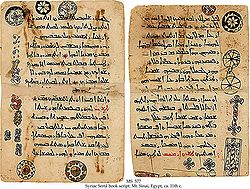
Irmologion, (Melchite Use). Depicted are Irmos 705-709 (Syriac Sertâ book script. 11th century, St. Catherine's Monastery, Mt. Sinai.
Irmologion (Greek: εἱρμολόγιον (heirmologion)) is a liturgical book of the Eastern Orthodox Church and those Eastern Catholic Churches which follow the Byzantine Rite, and it contains texts for liturgical singing in Church.[1] Specifically, it contains irmoi (introductory hymns) for the various canons which are chanted at Matins and other services. The word derives from the words εἱρμός (heirmos) meaning "link" i.e. an introductory stanza and λογεύω (logeuō) meaning "to collect".
An important portion of Matins and other services in the Orthodox Church is the Canon, a long liturgical poem divided into nine Odes. Each Ode begins with a hymn called an Irmos. Many of the Odes also end with a type of Irmos called a Katabasia. The majority of a canon (the troparia) is performed by a reader, but the irmosi and katabasiae are chanted by the choir. Since the liturgical books containing the entire text of the canons can be expensive (especially in the days when books were copied by hand), and yet enough copies of the parts which are sung must be provided for the singers, the Irmologion was developed as an anthology containing only those parts of the canons which are chanted by the choir. Following the development of the Irmologion, the service books which provide the text for the canons would often not print the entire text of the irmosi and katabasiae, but only the first few words, making the Irmologion indispensable for the chanting of the services.
Within the Irmologion, the irmoi are arranged according to the eight tones of Byzantine chant.
The Irmologion also contains the following:
- Antiphons of the Divine Liturgies of St. John Chrysostom, St. Basil the Great, and the Presanctified Gifts
- Dogmatica, hymns in honour of the Virgin Mary which are chanted at the Little Entrance at Vespers
- Anthems in honour of the Virgin Mary
- Orthron anthems for three voices
- Troparia of the Resurrection in the eight tones
- The full text of the Polyeleos (Psalms 134 and 135; also Psalm 136, which is used during the Pre-Lenten Season), which is chanted at Matins on Sundays and feast days
- Songs of praise for feasts and saints
- Anabathmoi, or "Hymns of Ascent", based upon Psalms 119-133
- Prokimena
- Troparia and Canticles of the Resurrection
- Biblical Odes, which form the basis for the canons and are still used on weekdays during Great Lent
History[]
The Irmologion was first compiled in Greek from a number of irmoi in the 10th century in Byzantium. A full version of the Russian Irmologion, in Church Slavonic includes about 1050 irmoi. Earlier examples provided only the written text; later, the "hooks" and "banners" of Znamenny Chant were added above the text. The first printed edition of a notated Irmologion in Russia,the Irmologiy notnago peniya, using neumes (square notes) on a staff, was published in 1772. Today, most Irmologia are printed using modern musical notation (with the exception of some Old Believer groups, which continue to use the older Znamenny or neumes).
References[]
External links[]
- Selections from the Irmologion (in English)
| |||||||||||
ru:Ирмологий uk:Ірмологіон